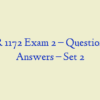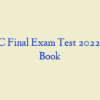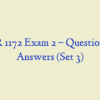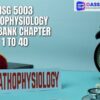Description
NUR 2063 Essentials of Pathophysiology Final Exam – Ramussen
184 Question and Answers
- Neither recessive nor dominant—co-dominant.
- blood flow reestablished to quickly
- Life-threatening complication of many conditions
- thyroid gland – T3, T4, calcitonin parathyroid gland – parathyroid hormone
- altered level of consciousness BP drops
- chest pain that occurs while a person is at rest and not exerting himself does not get better
- Abnormally low white blood cell count
- damage to the alveoli air can get in, but not out emphysema lecture
- Manifestations
- Not enough ADH
- Homozygous.
- Frequently caused by aspirin—prevents the conversion of prostaglandins, which stimulate leukotriene release, a powerful bronchoconstrictor.
- pulmonary edema, wet coughing, shortness of breath, and dyspnea
- Result from direct injury to the spinal cord or indirectly from damage to surrounding bones, tissues, or blood vessels.
- high blood pressure damages two organs
- Tends to be more sudden and severe
- Chronic inflammatory disease characterized by thickening and hardening of the arterial wall.
- kidney injury and prerenal injury can lead to
- Second most common blood cancer
- Increased volume in the cranial cavity
- Thalassemia major is the most severe form of beta thalassemia. It develops when beta globin genes are missing. The symptoms of thalassemia major generally appear before a child’s second birthday. The severe anemia related to this condition can be life-threatening.
- Left ventricle cannot maintain adequate cardiac output.
- decreased blood volume
- Blue bloaters”
- Prolonged elevation in blood pressure.
- strokes caused by blockage in a blood vessel in the brain Ischemic damage is permanent
- Staging
- make glucagon – helps raise blood sugar levels
- has Reed-Sternberg cells
- Manifestations: dyspnea, labored and shallow respirations, rales, productive cough with frothy sputum, hypoxia, cyanosis, fever, hypotension, tachycardia, restlessness, confusion, lethargy, and anxiety
- inflammation of the meninges
- damage to the brain caused by a different disorder injury responding to something else
- Another word for homeostasis
- No Reed-Sternberg cells
- objective evidence of disease such as a fever
- Primary Infection
- Caused by a reaction to substances at work.
- Debilitating chronic disorders characterized by irreversible, progressive tissue degeneration and airway obstruction.
- shows brain’s electrical activity by positioning electrodes over the scalp
- Vary depending on the degree of damage and the specific nerves affected.
- Heterozygous.
- paralysis caused by damage to the area of the brain responsible for movement no cure can be first noticed in utero
- A condition that occurs when there is widespread dilation of the small arterioles, small venules, or both.
- make insulin – take glucose into cells
- Manifestations
- Acquired outside the hospital or healthcare setting
- Most common form Develops gradually over time
- Decreased blood volume or circulatory stagnation resulting in inadequate tissue and organ perfusion
- Makes protein
- Rapidly developing respiratory failure
- acidosis alkalosis respiratory metabolic
- widespread simultaneous bleeding and clotting
- Result from meningeal irritation and neurologic damage.
- level of consciousness
- What to do if a suspected spinal cord injury
- oxygen levels are down CO2 levels are up
- X-linked recessive bleeding disorder
- Venous return reduces because of external blood volume losses.
- Manifestations: leukopenia, anemia, thrombocytopenia, lymphadenopathy, joint swelling, bone pain, weight loss, anorexia, hepatomegaly, splenomegaly, and central nervous system dysfunction
- fast metabolism weight loss thin agitated elevated HR hot
- a hormone cascade pathway that helps regulate blood pressure and blood volume kidney secretes it
- An inflammation of the skin caused by having contact with allergens
- Confined to a single lobe
- pressure inside the skull swelling in brain
- inflammation of the appendix right lower quadrant pain
- Develops more than 48 hours after a hospital admission
- the gland that secretes ADH Anti-diuretic hormone also called vasopressin
- syndrome of inappropriate antidiuretic hormone too much ADH
- Affects primarily adults
- chest pain that persists shoulder pain jaw pain
- 22-26
- pH below 7.35
- pH above 7.45
- subjective evidence of a disease, such as pain or a headache
- Causes: infectious agents, injurious agents or events, and pulmonary secretion stasis
- Excessive allergic reaction
- Complications: myocardial infarction, heart failure, dysrhythmias, and sudden death
- occurs when a blood vessel in the brain leaks or ruptures; also known as a bleed
- both sides of heart failure will cause this to be compromised
- Inflammation of the tracheobronchial tree or large bronchi
- Occurs in the areas between the alveoli
- demyelination – destruction to the myelin sheath disruptions in nerve impulse conduction
- calcium and phosphorus are stored there
- “Pink puffers.”
- Causes: impaired gag reflex, improper lower esophageal sphincter closure, inappropriate gastric tube placement
- system wide infection severe inflammation due to a pathogen
- atherosclerotic plaque builds up and damages the endothelium of the coronary arteries
- stress hormone released by the adrenal glands on kidneys
- computed tomography scan
- Narrowing of the peripheral vessels
- A genetic disorder that is present at birth and affects both the respiratory and digestive systems. excessive amounts of mucus in lungs
- Inflammation of the brain and spinal cord, usually resulting from an infection.
- fatigue pale shortness of breath heavy breathing
- a condition caused by prolonged exposure to high levels of cortisol
- chest pain that occurs when a person is active or under severe stress will get better
- pressure change in lungs
- A condition associated with closed TBIs momentary interruption of brain function
- emphysema chronic bronchitis
- damage directly to the brain
- Atherosclerotic changes of the coronary arteries
- increased intensity or frequency, does not go away with demand reduction, or occurs at rest
- Peripheral edema (legs and hands common)
- two kinds:
- An immunological disorder in which the immune system turns against itself
- Hypertension first seen in pregnancy
- Cancers affect lymphatic system
- A disorder of the central nervous system that affects, motor, movement, often including tremors. neurotransmitter lacking
- another name for stroke oxygen and blood flow is lacking to the brain
- air sacs in the lung where gas exchange occurs.
- inflammation of the bladder
- Seizure: transient physical or behavior alteration that results from an abnormal electrical activity in the brain
- swollen, varicose veins at the lower end of the esophagus liver is the problem
- can’t be changed age, family history
- electrolytes that are higher concentrated within the cell
- cancer cells that spread
- low oxygen extreme pain trouble breathing hemoglobin is crescent shaped
- lungs – narrow and constrict capillary – dilate / increase
- loss of bone density
- Death of the myocardium.
- Manifestations: cyanotic or plethoric skin, high blood pressure, tachycardia, dyspnea, headaches, visual abnormalities
- Manifestations: productive and nonproductive cough, dyspnea, wheezing, low-grade fever, pharyngitis, malaise, and chest discomfort
- First stage – clotting vascular spasm Platelets aggregate
- Epilepsy: seizure disorder resulting from spontaneous firing of abnormal neurons; characterized by recurrent seizures for which there is no underlying or correctable cause
- Chronic disorder that results in intermittent, reversible airway obstruction
- the inability to control the voiding of urine under physical stress such as running, sneezing, laughing, or coughing
- Inflammation of the meninges, usually resulting from an infection.
- compression or severing to the spinal cord disc herniation
- A decrease of plasma protein. The pressure change causes a fluid shift.
- Cervical injuries can affect both the upper and lower extremities and include breathing difficulties, loss of normal bowel and bladder control, paresthesia, sensory changes, spasticity, pain, weakness, paralysis, blood pressure instability, temperature fluctuations, and diaphoresis.
- Results from a decreased number of erythrocytes, reduction of hemoglobin, or presence of abnormal
- Respiratory Opposite Metabolic Equal
- low blood sodium neurological problems
- Usually caused by a sudden and violent blow or jolt to the head (closed injury) or a penetrating (open injury) head wound that disrupts the normal brain function.
- Affects primarily adults
- low platelet count
- inflammation of the lungs immunocompromised people are most at risk for this
- sudden symptoms of insufficient blood supply to the heart indicating unstable angina or acute myocardial infarction
- Diagnosis: history, physical examination (including using the Glasgow Coma scale), head computed tomography, head magnetic resonance imaging, and ICP monitoring
- clot or other material lodges in vessels of the lung
- Increased IgE synthesis and airway inflammation, resulting in mast cell destruction and inflammatory mediator release.
- Manifestations: hypoventilation, hypoxemia, cyanosis, hypercapnia, polycythemia, clubbing of fingers, dyspnea at rest, wheezing, edema, weight gain, malaise, chest pain, and fever
- Manifestations: fever, chills, mental status changes, nausea, vomiting, photophobia, severe headache, stiff neck (meningismus), agitation, bulging fontanel, decreased consciousness, opisthotonos (abnormal positioning that involves rigidity and severe arching of the back with the head thrown backward), poor feeding or irritability in children, tachypnea, and rash
- Abnormally high erythrocytes
- Caused by the bacillus, Mycobacterium tuberculosis
- Secondary infection
- Usually occurs between 3:00 and 7:00 a.m.
- 7.35-7.45
- Leads to DVT venous Stasis (sluggish), increase blood coagulation, damage to vein wall (endothelial damage)
- electrocardiogram diagnostic tool used for Myocardial Infarction looks at 12 angles
- involves the compression of nerves and blood vessels due to swelling within the enclosed space created by the fascia that separates groups of muscles
- Manifestations: dyspnea upon exertion, diminished breath sounds, wheezing, chest tightness, tachypnea, hypoxia, hypercapnia, increased anterior-posterior thoracic diameter (from 1:2 to 1:1), activity intolerance, anorexia, and malaise
- goes away with demand reduction
- which factor involved with Hemophilia A
- A DVT in the lower extremity can cause this
- air in pleural space
- inflammation of the brain tissue
- change in level of consciousness can do an EEG
- Complications
- Not an allergic reaction
- Affects primarily children
- Most common form of dementia.
- Affects primarily adults
- Manifestations
- Usually occurs 10-15 minutes after activity.
- The process of inspiration and expiration
- changeable or controllable life style, smoking, diet
- mom to baby
- Controls fight or flight response Heart rate increases
- complicated condition that can occur when someone has severe sepsis or septic shock.
- Manifestations: tissue ischemia and abnormal bleeding
- constipation tired gain weight cold
- Life-threatening condition resulting in severe lung damage and nutrition deficits
- Manifestations: productive cough, hemoptysis, night sweats, fever, chills, fatigue, unexplained weight loss, anorexia, and symptoms depending on other organ involvement
- Autosomal dominant inheritance
- Inadequate pumping
- A form of peripheral vascular disease in which there is partial or total blockage of an artery, usually one leading to a leg or arm.
- Manifestations
- wheezing SOB – shortness of breath cough
- Manifestations: meconium ileus, salty skin, steatorrhea, fat-soluble vitamin deficiency, chronic cough, hypoxia, fatigue, activity intolerance, audible rhonchi, and delayed growth and development
- Most frequent type
- yellow skin yellow sclera
- Air in the pleural cavity
- 35-45
- Especially intense form





